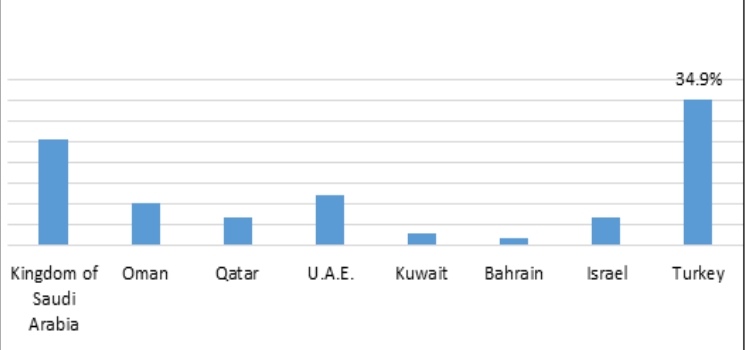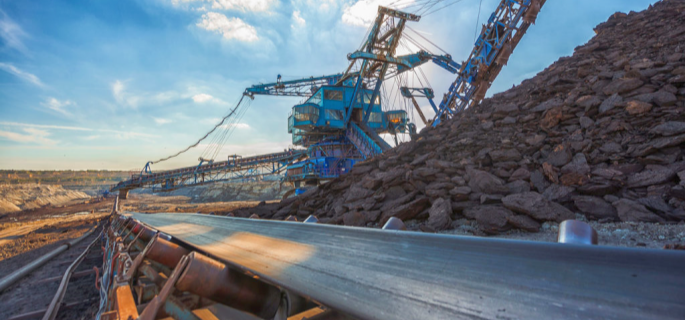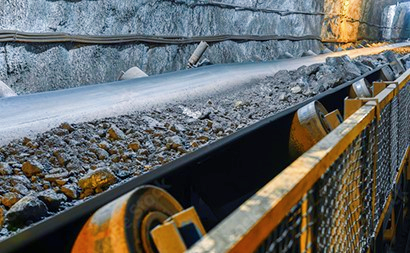Middle East Conveyor Belts Market Trends Analysis
The Middle East conveyor belts market stands as a pivotal component in the global industrial landscape. This market, characterized by its dynamic growth and technological advancements, plays a crucial role in shaping the region’s industrial capabilities. The significance of the conveyor belt market in the Middle East is not just confined to its geographical boundaries but extends globally, influencing various sectors from manufacturing to logistics. The market size, currently valued in billions, is a testament to its impact on regional industrial growth, setting a benchmark for efficiency and innovation in conveyor belt technology.
Middle East Conveyor Belts Market Outlook (2023 to 2033)
The Middle East conveyor belts market is projected to grow significantly from 2023 to 2033, with a compound annual growth rate (CAGR) of 4.6%. The market, valued at approximately USD 216 million in 2023, is expected to reach around USD 338.7 million by 2033. Several factors contribute to this growth, including the region’s ongoing industrialization and infrastructure development.
Key Market Drivers:
- Industrial and Infrastructure Expansion: Rapid industrialization and urbanization in countries like Saudi Arabia, the UAE, and Qatar drive the demand for conveyor belts. These nations are investing heavily in logistics, construction, and manufacturing sectors.
- Technological Advancements: Integration of advanced technologies such as automation, Internet of Things (IoT), and artificial intelligence (AI) enhances the efficiency and functionality of conveyor systems.
- E-commerce and Logistics Growth: The expansion of e-commerce and the need for efficient logistics solutions are boosting the demand for conveyor systems in warehouses and distribution centers.
Market Segmentation:
- By Product Type: Metal-reinforced rubber, fabric-reinforced rubber, and plastic conveyor roller belts.
- By Cover Type: Conductive, abrasion-resistant, heat- and flame-resistant, and oil-resistant conveyor belts.
- By Weight: Lightweight, medium-weight, and heavyweight belts, with the medium-weight segment holding a significant market share due to its balance of speed and capacity.
- By Application: Mining, food production, commercial, construction, automotive, and chemical industries, among others. The mining sector, in particular, is a major contributor, accounting for a substantial market share.
Regional Insights:
Saudi Arabia is the largest market for conveyor belts in the Middle East, supported by substantial government investments aimed at diversifying the economy beyond oil. This includes a $1 trillion investment in logistics and industrial sectors.
Competitive Landscape:
The market features strong competition with key players such as Al Kuwaiti Industrial Solutions, Arabian Universal, Bridgestone Corporation, ContiTech AG (Continental AG), Derby Conveyor Belts, Fenner Dunlop Conveyor Belting, and more. These companies are focusing on research and development to introduce innovative and durable conveyor belt solutions.
Overall, the Middle East conveyor belts market is poised for robust growth, driven by technological advancements, industrial expansion, and strategic government investments in infrastructure and logistics.

Key Factors Driving the Middle East Conveyor Belts Market
The Middle East conveyor belts market is experiencing notable growth, driven by several key factors:
1. Industrial and Infrastructure Development
The ongoing industrialization and infrastructure expansion in the Middle East are significant drivers. Countries like Saudi Arabia, the UAE, and Qatar are heavily investing in logistics, manufacturing, and construction sectors, which in turn increases the demand for efficient material handling solutions such as conveyor belts.
2. Technological Advancements
The integration of advanced technologies like automation, the Internet of Things (IoT), and artificial intelligence (AI) is enhancing the efficiency and functionality of conveyor systems. These technologies help in real-time monitoring, predictive maintenance, and overall system optimization, making conveyor belts more reliable and efficient.
3. E-commerce and Logistics Growth
The rise of e-commerce and the need for efficient logistics solutions have significantly boosted the demand for conveyor systems in warehouses and distribution centers. The efficient handling and transportation of goods are critical in these sectors, driving the adoption of advanced conveyor belt systems.
4. Government Investments and Policies
Governments in the region are making substantial investments to diversify their economies and reduce dependence on oil. For example, Saudi Arabia has announced a $1 trillion investment in logistics and industrial sectors as part of its Vision 2030 plan. Such initiatives create a favorable environment for the growth of the conveyor belts market.
5. Growth in the Mining Sector
The mining industry is a major consumer of conveyor belts, and its growth significantly impacts the conveyor belts market. Conveyor belts are essential for transporting bulk materials in mining operations. The mining sector’s demand for durable and efficient conveyor systems contributes substantially to market growth.
6. Competitive Landscape and Innovation
Key players in the market, such as Bridgestone Corporation, ContiTech AG, and Fenner Dunlop, are investing in research and development to introduce innovative and durable conveyor belt solutions. These companies are focusing on enhancing product performance, reducing maintenance costs, and meeting the specific needs of various industries.
7. Regional Market Dynamics
Saudi Arabia is the largest market for conveyor belts in the Middle East, driven by its substantial investments in logistics and industrial infrastructure. The UAE and Qatar are also significant contributors due to their ongoing modernization and infrastructure projects .
These factors collectively contribute to the robust growth and positive outlook of the Middle East conveyor belts market from 2023 to 2033.

Market Size of Middle East Conveyor Belts Market
Middle East Conveyor Belts Market to Cross USD 338.791 Billion Mark by 2033, Driven by a Steady 4.6% CAGR Growth.
The Middle East conveyor belts market currently boasts a significant valuation of USD 216.08 billion as of 2023, with projections indicating a rise to USD 338.791 billion by 2033. This dynamic market demonstrates a clear trajectory of upward momentum, having experienced notable growth from its 2022 valuation of USD 207.570 billion.
The driving force behind this remarkable surge stems from a convergence of factors, with escalating infrastructural activities unfolding across the Middle East acting as a primary catalyst. As the region undergoes substantial expansion in construction, logistics, and various industries, conveyor belts are emerging as indispensable tools for streamlined material handling and transportation. These belts have evolved into essential components of modern industrial processes, facilitating the seamless movement of goods, raw materials, and products across diverse sectors.
The dynamic surge in infrastructural endeavors within the Middle East, coupled with the escalating integration of robotic process automation and cutting-edge material handling equipment, has positioned the region’s conveyor belt market as a pivotal industrial cornerstone. This ascendancy underscores its indispensable role, warranting a favorable prognosis.
Conveyor belts, a linchpin of materials handling equipment, attain paramount significance in this landscape. Fueled by burgeoning industry expansion across the Middle East, these belts emerge as coveted assets. An examination of historical data reveals the Middle East conveyor belt market’s impressive 4.1% Compound Annual Growth Rate (CAGR).
Simultaneously, the conveyor parts market is undergoing an era of profound technological evolution. The advent of Internet of Things (IoT), Artificial Intelligence (AI), and the ushering of 5G have orchestrated monumental advancements. These technological strides hold the potential to reshape the industry’s fabric, heralding a realm of elevated possibilities.
The Middle East conveyor belts market size is estimated to be valued at approximately USD 247.6 billion in 2024. The market is expected to exhibit a compound annual growth rate (CAGR) of around 42% from 2024 to 2031. This substantial growth is driven by various factors, including significant infrastructure development, industrial expansion, technological advancements, and the rise of e-commerce in the region.
Market Growth in the Middle East Conveyor Belts Market
The Middle East conveyor belts market is a rapidly growing sector, reflecting the region’s industrial expansion and modernization efforts. As of 2023, this market is valued at a substantial figure, with projections indicating a steady growth trajectory. The expected Compound Annual Growth Rate (CAGR) of 4.6% from 2023 to 2033 underscores the market’s robustness and potential for future expansion. This growth is fueled by several factors, including infrastructural developments, increased automation in industrial processes, and the rising demand for efficient material handling solutions across various industries.
Future Projections
The current market size of conveyor belts in the Middle East is a clear indicator of the region’s industrial strength and its commitment to adopting advanced technologies. The market’s valuation, running into billions of dollars, reflects the extensive use of conveyor belt systems in critical sectors such as mining, manufacturing, logistics, and material handling. The forecasted growth rate further emphasizes the market’s potential, with an expected significant increase in market value by 2033. This growth trajectory is indicative of the increasing reliance on conveyor systems for operational efficiency and productivity in the region’s industrial sectors.
Comparison with Other Global Markets
To put the Middle East conveyor belts market into perspective, it’s insightful to compare it with other significant markets, such as India. The conveyor belt market size in India is another example of rapid industrial growth, driven by similar factors like infrastructure development and industrial automation. However, the Middle East market distinguishes itself through its unique regional demands, such as the need for high-temperature resistant belts in oil and gas applications and the integration of advanced technologies like IoT and automation for enhanced operational efficiency.
The comparison reveals that while each market has its unique characteristics and challenges, they collectively contribute to the global conveyor belt industry’s growth. The Middle East market, with its strategic geographical location and investment in industrial advancements, is positioned as a key player in shaping global trends in conveyor belt technology and applications.
Global Perspective and Regional Impact
The growth of the conveyor belt market in the Middle East has a significant impact not only regionally but also on a global scale. The market’s expansion is closely linked to the region’s overall economic growth, infrastructure development, and industrial diversification. As the market grows, it attracts global players and investors, further integrating the Middle East into the global industrial fabric.
The Middle East conveyor belts market is a rapidly evolving sector, marked by significant growth, technological advancements, and a substantial impact on both regional and global industrial landscapes. The market’s current size and projected growth reflect the region’s commitment to industrial modernization and efficiency, making it a key player in the global conveyor belt industry.

Key Market Drivers in the Middle East Conveyor Belts Market
The Middle East conveyor belts market is experiencing significant growth, driven by a combination of regional and global factors. Understanding these drivers is crucial for stakeholders in the industry to capitalize on emerging opportunities and to align their strategies with market trends.
Infrastructure Improvements
One of the primary drivers of the conveyor belt market in the Middle East is the substantial investment in infrastructure development. The region has seen a surge in projects related to transportation, logistics hubs, and industrial parks. These projects often require extensive conveyor belt systems for material handling, thus directly boosting the market.
- Transportation and Logistics: The development of new airports, seaports, and logistics centers in the Middle East necessitates advanced conveyor belt systems for efficient handling and movement of goods.
- Industrial and Economic Cities: Many countries in the Middle East are focusing on building industrial cities and economic zones, which include manufacturing plants and processing facilities, where conveyor belts are essential for operations.
Industry Automation
Another significant driver is the increasing automation in various industries. As the Middle East moves towards more technologically advanced manufacturing and processing methods, the demand for sophisticated conveyor belt systems rises.
- Manufacturing Sector: Automation in the manufacturing sector has led to the adoption of conveyor systems that can handle high-speed operations and complex material handling requirements.
- Food and Beverage Industry: In the food and beverage industry, there is a growing need for conveyor belts that meet hygiene standards and can handle delicate products efficiently.
Comparison with Global Trends
The drivers of the conveyor belt market in the Middle East align with several global trends:
- Global Industrial Automation: Similar to global trends, the Middle East is embracing industrial automation, leading to increased demand for conveyor systems.
- Sustainability and Efficiency: Globally, there is a push towards more sustainable and efficient operations. The Middle East market is also reflecting this trend, with a growing demand for energy-efficient and eco-friendly conveyor belt solutions.
The Middle East conveyor belts market is being driven by significant investments in infrastructure and a shift towards industry automation. These drivers are in line with global trends, positioning the Middle East as a key player in the global conveyor belt industry.

Market Challenges and Opportunities in the Middle East Conveyor Belts Market
The Middle East conveyor belts market, while experiencing robust growth, also faces several challenges. These challenges, however, present unique opportunities for market players to innovate and adapt.
Market Challenges
- Economic Fluctuations: The Middle East economy, heavily reliant on oil prices, experiences fluctuations that can impact industrial investment and, consequently, the conveyor belt market.
- Geopolitical Tensions: The region is known for its complex geopolitical landscape, which can affect trade and industrial activities, leading to market uncertainties.
- Supply Chain Disruptions: Global and regional conflicts or disruptions can impact the supply chain, affecting the availability and cost of conveyor belts.
Opportunities from Challenges
- Diversification and Innovation: Economic fluctuations encourage diversification in industries, leading to the exploration of new applications for conveyor belts.
- Sustainable Solutions: Environmental concerns and the global push for sustainability are leading to the development of eco-friendly and energy-efficient conveyor belts.
- Adaptation to Market Needs: Geopolitical challenges encourage local production and customization, offering opportunities for regional manufacturers to tailor solutions to specific market needs.
The Middle East conveyor belts market faces challenges that are shaping its growth trajectory. Economic and geopolitical factors, while posing hurdles, also open avenues for innovation and adaptation, allowing market players to offer solutions that are sustainable, efficient, and tailored to regional needs.
Regional Market Dynamics in the Middle East Conveyor Belts Market
The Middle East conveyor belts market is characterized by its diverse and dynamic regional outlook. This market’s growth is significantly influenced by the industrial sectors predominant in the region, such as oil and gas, mining, and manufacturing. The contributions of key countries like the UAE, Saudi Arabia, and Qatar are pivotal in driving the market’s expansion.
Industrial Sectors Driving the Market
- Oil and Gas: The Middle East, being one of the largest producers of oil and gas globally, heavily relies on conveyor belt systems for the transportation and processing of raw materials. Conveyor belts in this sector are specialized to handle the harsh conditions of oil extraction and processing, including resistance to oil and chemicals.
- Mining: The region’s mining industry, though not as prominent as oil and gas, is a significant user of conveyor belts. These belts are used for transporting mined materials like phosphate, gold, and other minerals. The harsh mining environment demands durable and high-capacity conveyor belts.
- Manufacturing: The manufacturing sector in the Middle East, encompassing automotive, food and beverage, and other industries, increasingly relies on conveyor belts for efficient production lines. The demand for automated and customized conveyor systems is growing in this sector.
Contributions of Key Countries
- United Arab Emirates (UAE): The UAE’s focus on diversifying its economy has led to growth in manufacturing and logistics sectors, thereby increasing the demand for conveyor belts. The country’s strategic position as a logistics hub also contributes to the market growth.
- Saudi Arabia: With its massive oil and gas sector, Saudi Arabia is a significant market for conveyor belts. The country’s Vision 2030 initiative, which aims to diversify the economy, is expected to further boost the demand for conveyor systems in other industrial sectors.
- Qatar: Qatar’s investment in infrastructure development, especially post its winning bid for the FIFA World Cup 2022, has led to an increased demand for conveyor belts in construction and related industries.
The Middle East conveyor belts market is driven by the region’s strong industrial sectors, with significant contributions from key countries. The market dynamics are shaped by the specific industrial needs of these sectors and the economic diversification strategies of the regional economies.

Competitive Landscape in the Middle East Conveyor Belts Market
The competitive landscape of the Middle East conveyor belts market is a complex interplay of local and global manufacturers. This section analyzes the biggest conveyor belt manufacturers active in the Middle East and provides insight into how local manufacturers compete with global corporations.
Major Manufacturers in the Market
- Global Players: The market features prominent global manufacturers like Bridgestone, Continental AG, and Bando, known for their wide range of products and advanced technology. These companies have established a strong presence in the Middle East through partnerships, subsidiaries, or distribution networks.
- Local Manufacturers: Local manufacturers in the Middle East are emerging as strong competitors, offering products that are tailored to the regional market’s needs. These companies often have the advantage of understanding local market dynamics and can offer customized solutions more efficiently.
Competitive Strategies
- Customization and Flexibility: Local manufacturers often focus on providing customized solutions to meet specific industrial requirements in the Middle East, giving them an edge over global players.
- Technological Advancements: Global manufacturers compete by offering technologically advanced conveyor belts with features like IoT integration, energy efficiency, and high durability.
- Strategic Partnerships: Both local and global players engage in strategic partnerships and collaborations to expand their market reach and enhance their product offerings.
- After-Sales Services: Providing comprehensive after-sales services, including installation, maintenance, and repair, is a key strategy for companies to strengthen their market position.
The competitive landscape of the Middle East conveyor belts market is marked by the presence of both global and local manufacturers. Each brings unique strengths to the market, with global players offering technological advancements and local manufacturers providing customization and flexibility. The competition in the market fosters innovation and drives the development of more efficient and advanced conveyor belt solutions.
Customization and Local Solutions in the Middle East Conveyor Belts Market
Customization in the Middle East conveyor belts market is a key factor that shapes the industry, addressing specific needs and operational challenges of various sectors. The availability of custom conveyor belts in the Middle East region highlights the market’s adaptability and responsiveness to local industrial requirements.
Importance of Custom Conveyor Belts
- Meeting Specific Needs: Custom conveyor belts are designed to meet unique operational requirements, such as specific load capacities, belt speeds, and environmental conditions.
- Industry-Specific Solutions: Different industries have unique demands. For instance, the food industry requires belts that are easy to clean and maintain, while the mining industry needs belts that are robust and abrasion-resistant.
- Adaptability: Custom solutions allow for greater adaptability in terms of size, shape, and functionality, making conveyor systems more efficient and effective.
Customization Shaping the Market
- Innovation and Development: The demand for customized solutions drives innovation and development in conveyor belt technologies.
- Competitive Edge: Manufacturers offering customization options can gain a competitive edge by addressing niche market segments.
- Local Manufacturers’ Role: Local manufacturers in the Middle East are particularly adept at providing customized solutions, understanding regional needs and challenges better.
Customization in the conveyor belt market is not just about creating a product that fits; it’s about enhancing operational efficiency, ensuring safety, and optimizing costs. The Middle East market’s focus on customization reflects its commitment to meeting the diverse needs of its industrial sectors.
Technological Advancements and Partnerships in the Middle East Conveyor Belts Market
Technological advancements and strategic partnerships are key elements driving the Middle East conveyor belts market. Innovations in conveyor belt technology and collaborations among market players play a crucial role in maintaining competitiveness and meeting evolving industrial demands.
Novel Advancements in Conveyor Belt Technology
- Smart Conveyor Belts: Incorporation of IoT and sensors for monitoring belt health, tracking usage, and predicting maintenance needs.
- Energy-Efficient Designs: Development of energy-efficient conveyor belts that reduce operational costs and environmental impact.
- Advanced Materials: Use of new materials that offer better durability, flexibility, and resistance to various operational stresses.
Recent Partnerships and Collaborations
- Global and Local Alliances: Partnerships between global manufacturers like Bridgestone and Continental AG with local distributors and companies in the Middle East.
- Joint Ventures for Innovation: Collaborations focusing on research and development to create advanced conveyor belt solutions.
- Supply Chain Enhancements: Strategic alliances to streamline supply chains, ensuring efficient delivery and installation of conveyor belts.
These technological advancements and partnerships are vital for the Middle East conveyor belts market. They facilitate the adoption of cutting-edge solutions, enhance operational efficiencies, and enable the market to meet the growing and changing demands of various industrial sectors.
Get expert advice on choosing the best conveyor belts.
FAQs about Middle East Conveyor Belts Market
The global conveyor belt market size is substantial and continues to grow. The market was valued at several billion dollars and is expected to expand at a steady rate. This growth is driven by increasing industrialization, advancements in material handling technology, and the rising demand in sectors such as mining, manufacturing, and logistics. The exact market size can vary yearly and is best determined by consulting current market research reports for the most recent figures.
Some of the biggest companies in the conveyor belt market are known for their extensive product ranges, global presence, and technological innovation. Notable names include:
Bridgestone Corporation: A global leader known for high-quality rubber conveyor belts.
Continental AG: Renowned for a wide range of conveyor belt solutions and related services.
Fenner Group Holdings Ltd: Offers a comprehensive range of conveyor belts and services.
Intralox: Specializes in modular plastic conveyor belts with a focus on innovative solutions.
Habasit AG: Known for its customized conveyor and processing belts.
The “best” conveyor belt companies are often those that offer high-quality products, innovative solutions, and excellent customer service. Some top-rated companies include:
Intralox: Praised for its innovative modular belt technology.
Habasit AG: Known for high-quality and tailored conveyor belt solutions.
Bando Chemical Industries: Offers a wide range of durable conveyor belts.
Ammeraal Beltech: Recognized for its comprehensive range and global service network.
Forbo Movement Systems: Specializes in lightweight conveyor belting solutions.
Conveyor belts have been around for over a century. The first recognizable conveyor belt system was introduced in the late 19th century. Around 1892, Thomas Robins began a series of inventions that led to the development of a conveyor belt used for carrying coal, ores, and other products. Since then, conveyor belt technology has evolved significantly, incorporating advanced materials and automation to meet modern industrial demands.
Last Updated on July 18, 2024 by Jordan Smith
Jordan Smith, a seasoned professional with over 20 years of experience in the conveyor system industry. Jordan’s expertise lies in providing comprehensive solutions for conveyor rollers, belts, and accessories, catering to a wide range of industrial needs. From initial design and configuration to installation and meticulous troubleshooting, Jordan is adept at handling all aspects of conveyor system management. Whether you’re looking to upgrade your production line with efficient conveyor belts, require custom conveyor rollers for specific operations, or need expert advice on selecting the right conveyor accessories for your facility, Jordan is your reliable consultant. For any inquiries or assistance with conveyor system optimization, Jordan is available to share his wealth of knowledge and experience. Feel free to reach out at any time for professional guidance on all matters related to conveyor rollers, belts, and accessories.





